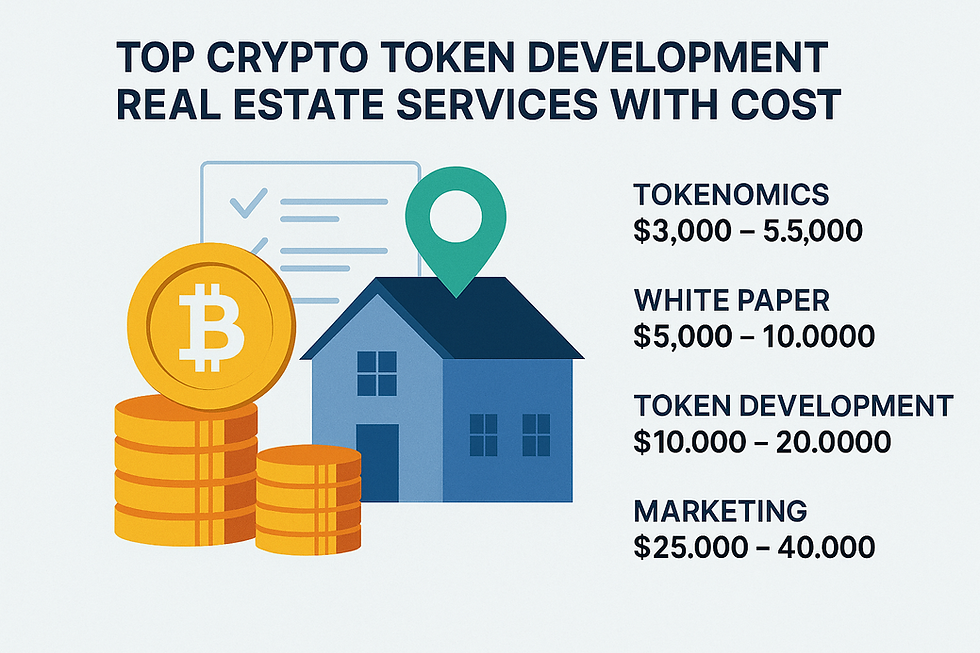Start Real World Asset Tokenization: A Complete Guide
- steveganger
- Jun 19
- 4 min read
Welcome to your go-to guide on how to Start Real World Asset Tokenization. Whether you're a business owner, investor, or curious about how blockchain is changing traditional finance, you're in the right place.
Let’s dive into the fascinating world of tokenizing physical assets and how you can be a part of this digital revolution.
Introduction to Real World Asset Tokenization
Tokenization of real world assets (RWAs) is one of the hottest trends in blockchain today. It allows tangible, often illiquid assets—like real estate, art, or commodities—to be represented digitally on a blockchain. This means more people can invest in assets previously reserved for the wealthy few.
What Are Real World Assets (RWAs)?
RWAs are tangible or intangible physical assets that hold value in the traditional economy. They can range from your apartment to a rare painting, or even a stake in a startup.
Common Types of Real World Assets
Real Estate
From single-family homes to skyscrapers, real estate is among the most commonly tokenized assets. Why? Because it's expensive and often illiquid. Tokenization solves both problems.
Commodities
Think gold, silver, or oil. These can be tokenized to allow fractional ownership and easier transferability.
Fine Art and Collectibles
Ever wanted to own part of a Picasso? Now you can, thanks to tokenization.
Intellectual Property
Music royalties, patents, and even movies can be tokenized and monetized.
What Is Asset Tokenization?
Asset tokenization is the process of converting ownership rights in a real world asset into a digital token on the blockchain.
How It Works
The asset is evaluated and legally verified.
A smart contract is created representing ownership rights.
Tokens are minted based on that contract.
Investors can buy, sell, or trade these tokens.
Token Standards Explained
ERC-20 for fungible tokens.
ERC-721 or ERC-1155 for non-fungible tokens (NFTs).
Each has unique benefits depending on the type of asset you want to tokenize.
Why Start Real World Asset Tokenization Now?
Market Growth and Opportunity
The tokenization market is projected to surpass $16 trillion by 2030. Those who start now are likely to ride the wave of early adoption.
Investor Demand and Liquidity
With increased demand for transparency and alternative investments, tokenization fills a much-needed gap. It’s easier to buy a token worth $100 in a building than buy the whole building!
Benefits of Real World Asset Tokenization
Enhanced Liquidity
Traditionally illiquid assets become tradable 24/7 on global digital markets.
Fractional Ownership
You don’t need a million dollars to invest in a luxury hotel. Buy a token, and you own a piece of it.
Global Accessibility
Tokenized assets can be purchased from anywhere, anytime, with just an internet connection.
How to Start Real World Asset Tokenization
Thinking about how to start real world asset tokenization? Follow these 5 practical steps:
Step 1: Choose the Right Asset
Select an asset with real demand and measurable value. It should also be easy to appraise and tokenize.
Step 2: Legal and Regulatory Compliance
Consult legal professionals to ensure you're compliant with security laws in your jurisdiction. This step is non-negotiable.
Step 3: Select a Blockchain Platform
Choose a robust blockchain like Ethereum, Polygon, or Solana depending on your scalability, cost, and security requirements.
Step 4: Develop or Use Tokenization Tools
Use tokenization platforms like Polymath, Tokeny, or Securitize—or build your own solution.
Step 5: List on a Marketplace
Platforms like OpenSea, RealT, or tZERO allow listing and trading of tokenized assets.
Challenges and Risks in Tokenizing RWAs
Regulatory Ambiguity
Different countries have varying (and often unclear) laws around digital securities.
Valuation Complexities
Real world asset pricing can be subjective and fluctuate, making token valuations tricky.
Security Concerns
While blockchain is secure, smart contract bugs and poor custodianship can lead to vulnerabilities.
Use Cases and Examples
Real Estate Projects
RealT allows users to buy tokenized properties in Detroit and earn rental income.
Gold and Precious Metals
Companies like Paxos offer tokenized gold that is backed 1:1 with physical gold.
Tokenized Artwork
Masterworks lets investors buy shares in famous paintings, democratizing fine art ownership.
Future of Real World Asset Tokenization
Institutional Involvement
BlackRock, JPMorgan, and other giants are entering the space, giving it credibility and scale.
Cross-Border Asset Trading
Imagine a future where you can invest in a vineyard in Italy or a condo in Tokyo—all from your phone.
The potential is limitless, and now is the time to start real world asset tokenization before the space becomes saturated.
Conclusion
Tokenizing real world assets isn’t just a tech buzzword—it’s the future of finance. If you've ever wanted to invest globally, own parts of rare assets, or provide liquidity to dormant holdings, then it’s time to start real world asset tokenization.
From real estate and art to gold and beyond, the digital transformation of ownership is unfolding right now. And the best part? You can be a part of it today.
FAQs
1. What is the first step to start real world asset tokenization?
Begin by selecting a valuable and legally verifiable real world asset, then consult with legal experts to ensure compliance.
2. Is real world asset tokenization legal?
Yes, but regulations vary by country. Always check with local authorities or legal counsel.
3. Can individuals tokenize their own assets?
Absolutely! With the right tools and legal compliance, even individuals can tokenize properties, art, or collectibles.
4. Which blockchain is best for asset tokenization?
Ethereum is the most popular due to its established ecosystem, but others like Polygon and Solana offer speed and lower fees.
5. How do I make money from tokenized assets?
Depending on the asset, you can earn through rent, royalties, resale, or appreciation in token value.







Comments